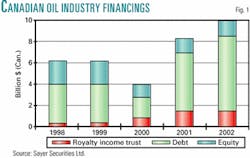The Canadian oil and natural gas industry's 2002 treasury financings totaled $9.98 billion (Can.)—the highest level in a decade—said Sayer Securities Ltd., an investment firm specializing in oil and gas mergers and acquisitions.
The 2002 record narrowly broke the 1995 record of $9.58 billion. In 2001, financings totaled $8.14 billion.
The debt category reached a record $7.02 billion. "Low and continually decreasing interest rates were the major factor," said Frank J.D. Sayer, founder and president of the Calgary-based company.
For example, "A"-rated corporate bonds opened 2002 at 6.83% and closed in December at 6.57%.
Equity markets
The equity and royalty income trust (RIT) categories also reflected solid growth. During the last 3 years, the equity total rose 42%, and the RITs total rose 73%.
Canadian law allows investors to buy tax equity vs. what Sayer calls real, or straight, equity, which mirrors the US equity market. Tax equity allows a company's tax deductions for oil and gas activities to flow through to the individual investor. In 2002, more than $300 million of tax equity was purchased.
New issues for total equities were $1.54 billion last year compared with $1.28 billion in 2001. The recent statistics demonstrate that more "real equity" money entered the market, as opposed to "tax equity" money, since an increase for straight equity was coupled with a decrease for flow-through issues, Sayer said.
Straight equity was up 32% in 2002 compared with 2001, while flow-through equity decreased 10%.
Equity financing has benefited from the creation of startup companies in recent years. As a group, startups completed 48% of the straight equity issues in 2002, up from 44% in 2001. In contrast, senior exploration and production companies, which led equity financings in the past, were missing in 2002, with the exception of Bonavista Petroleum Ltd., which completed an $80 million financing.
Debt issues
Many senior E&P companies chose 2002 to fix their long-term debt costs. This group included Canadian Natural Resources Ltd. (raising $1.73 billion in three transactions), Talisman Energy Inc. (raising $897 million in two transactions), and Suncor Energy Inc. (raising $804 million in a single issue).
Suncor accomplished the single largest Canadian E&P debt issue in 10 years.
Within the debt category, RITs demonstrated an appetite for straight debt. Enerplus Resources Fund completed an issue in June for $268.3 million. The only other straight debt issue by a conventional RIT in 5 years was by ARC Energy Trust in 2000 for $54.1 million, although the oil sands trusts previously have raised funds this way.
Another major change in the 2002 debt market was the large increase in convertible debt issues by RITs. Four entities chose this route for a total of $239.4 million.
"Only once before have we recorded a convertible debt issue by a RIT (NCE Energy Trust in 1999 for $16.1 million)," Sayer said.
While the larger trusts did the straight debt issues, the smaller RITs chose the convertible debt route. The four issuers were Viking Energy Royalty Trust ($75 million), Provident Energy Trust ($64.4 million), Advantage Energy Income Fund ($55 million), and Acclaim Energy Inc. ($45 million).
RIT unit issue totals remained strong even though several trusts raised funds through debt arrangements instead. In 2002, 14 entities raised $1.41 billion, virtually unchanged from $1.39 billion in 2001.
"The year 2003 may see a greater total, as the number of oil and gas trusts will increase to 20 (from 17 in both 2002 and 2001) with the finalization of shareholder votes regarding Vermilion Energy Trust, Paramount Energy Trust, and Avenir Diversified Income Trust," Sayer said.
Within the RITs, two organizations raised 52% of the total (Pengrowth Energy Trust for $405 million and Enerplus for $333.2 million). "This showed a dominance in the trust unit marketplace not prevalent in prior years. In 2001, the two top issuers (Pengrowth and NCE) raised just 34%," Sayer said.
While trusts continue to proliferate, several of them are pulling away from the pack, he noted. These issuers' size is helping their ability to raise money in the capital markets, decreasing their cost of funds compared with other smaller trusts.

